Revista Electrónica de Investigación Educativa
Vol. 9, Num. 2, 2007
Compulsory Secondary Education Students’ Interests
towards Physical Education
Juan Antonio Moreno
morenomu@um.es
Facultad de Ciencias del Deporte
Universidad de Murcia
Parque Almansa
San Javier 30730
Murcia, España
María Gloria Hellín
gloriahellin@yahoo.es
Facultad de Ciencias del Deporte
Unidad de Investigación de Educación Física y Deportes
Universidad de Murcia
Parque Almansa
San Javier 30730
Murcia, España
(Received: June 18, 2006;
accepted for publishing: April 12, 2007)
Abstract
Compulsory Secondary Education student’s opinion on Physical Education is a matter of great interest for teachers; there are numerous variables that determine it. This research analyzed the influence of the interest shown by students towards the course caused by different aspects: students’ grade level, gender, importance given to the class, their physical-sports practice, the context in which the class is given and the teacher’s Physical Education degree. To this end, a Questionnaire for Analyzing Students' Opinions on Physical Education (for its acronym in Spanish CAPAEF) was applied to a sample of 1,499 students in first and second grades of Compulsory Secondary Education, in the Murcia Region; the questionnaire was designed specifically for this research. As a result of this study, it was concluded that among the students who showed great interest for Physical Education, the objectives that stood out were related to health, education, competition and the curriculum of the courses of Physical Condition and Health as well as Games and Sports, but not Corporal Expression. These same students chose it as their favorite class, they did not accept reduction of hours, they considered the classes were useful, easy and motivating; they found a lot of support from the teacher, given that he had a good nature, was pleasant, comprehensive, cheerful and fair, besides of the fact that he was committed to the class.
Key words: Student motivation, physical education, interests, attitudes.
Introduction
Nowadays, there exists the need to incorporate culture and education with knowledge and skills that related to the body and physical activities contribute to personal development and a better quality of life. Therefore, incorporation of physical education in the curriculum is justified by student’s integral education and it has resulted in the study of student’s satisfaction as one of the issues of most interest.
Lopez and Gonzalez (2001) refer to satisfaction-dissatisfaction as a psychological state that results from the interaction of a set of affective experiences which move between the positive and negative poles as the activity satisfies the necessities and it corresponds to the motives and interests of the individual. Within every person, affective experiences are an expression of the process of satisfaction of his needs.
For the authors, affective experiences constitute indicators of the subjective relevance of the objects, phenomena, facts and situations with which each individual interacts. As the subject experiences the positive and negative poles (in this case those of the physical education class), he will be able to stand out from the cumulous of influences that act upon him by considering which ones are relevant for him, according to their attractive or repulsive overtone, which ones result to be indefinite and which impress him, as a mixture of the pleasant or unpleasant.
Earl and Stennett (1987), Fernandez Garcia (1995), Hellin and Moreno (2001a and 2001b), Moreno and Cervello (2003), Moreno Sanchez, Rodriguez, Prieto and Mula (2002), Luke and Sinclair (1991), and Ruiz (2000) are different authors with papers on students attitudes. In their findings, they consider that the level of satisfaction in Physical Education is conditioned by factors like curriculum content, sports practice (not only of the student, but his family and friends as well), teacher’s and the student’s gender, the importance given to the course by the student according to the teacher’s characteristics and the socialization of the physical-sports phenomenon influenced by the media.
Motivation constitutes an element of vital importance in the teaching and learning process. Florence (1991) notes that a motivated student manifests different behaviors in class: he is active, he is exhausted, he follows instructions, he questions, he helps his classmates, he wants to do more, he cuts in line, he is cheerful, he worries about his performance, he repeats his exercises and practices outside school hours. Overall, he feels pleasure and has the urge to work out and learn in his physical education class.
This motivation acts in different forms depending on whether it refers to an intrinsic or extrinsic type. Intrinsic motivation leads to a feeling of enjoyment, competence, skills or self-realization; it results in the student’s greater commitment and self-determination. While extrinsic motivation is in charge of external rewards, of any kind, that have to do with the regulation of student’s participation, especially when it’s successful.
Each motivation has a different effectiveness level when regulating the student’s activity. Therefore, the study of motivation, whether intrinsic or extrinsic, is important for a teacher since this allows him to develop educational strategies with the purpose of stimulating the interest for the course that is being given, as a factor that guarantees an effective learning (Lopez and Gonzalez, 2001).
In different research (Fox and Biddle, 1988; Lopez and Gonzalez, 2001; Martin Albo, 2000; Moreno, 1999) the student’s maximum satisfaction in the physical education class is characterized by the intrinsic motivation obtained directly from the activity, which leads the student to a greater participation, a feeling of competence, greater commitment and self -determination.
Satisfaction shown by the students in physical education classes is associated with motivational atmospheres generated within them. In this sense, Cervello (2000), Guitierrez (2000), and Papaioannou (1994, 1995, 1998) research papers point out that physical education classes with an orientation towards physical activities make students feel more satisfied with them. Escarti and Brustad (2000) suggest that individuals who are oriented towards tasks perceive sports and physical activity as activities that strengthen cooperation skills and social responsibility, as well as they increase their interest for learning and for being better citizens, abiding rules, making greater efforts and improving their health and their own skills in sports.
In this context, the objective of this paper is to analyze the relation between the interest towards physical education and the different factors involved with it: student’s grade level, gender, importance given to physical education, physical-sport practice, the context in which the class is given and the course teacher’s degree in Compulsory Secondary Education.
I. Method
1.1 Sample
The sample was made up of 1,499 students from the Murcia region, in Spain. 769 were female and 730 were male between the ages of 11 and 18, all of them in Compulsory Secondary Education, representing a margin of error of ±3 and a trust level of 95.5%.
1.2 Instrument
To collect data, a Questionnaire for Analyzing Students' Opinions in Physical Education (by its acronym in Spanish CAPAEF) was designed for this research. It had 22 questions, four of them were open ended and the rest were closed, grouped into four blocks: socio-demographic, physical education courses importance and assessment, aspects related with the professor and physical-sport habits.
1.3 Statistical Analysis
To obtain results, descriptive statistics were determined for all variables, their independence was analyzed with the Pearson’s Chi-square test, and they were applied the analysis of corrected typified residuals. The dependent variable was the Compulsory Secondary Education student’s opinion on physical education. The independent variables were: grade, student’s gender, the importance the student gives to physical education, his physical-sport practice, the context in which the class is given and the Physical Education professor’s degree.
II. Results
The information obtained on the interest shown by students toward Physical Education, showed that 62.9% of the students really liked the class, 33.8% of them said they liked it and 3.3% of them said they really dislike it.
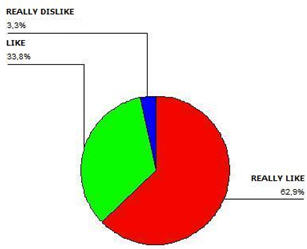
Figure 1. The percentage distribution of the simple
on the liking of Physical Education classes.
2.1 Results according to the Socio-Demographic data
As observed on Table I, 71.6% and 4.7% of those who answered they “Really like” and “Really dislike” PE respectively were male students. On the other hand, 43.3% of the students who “Like” were female, which produced significant differences (p<.001).
Among those who said they “Really like” PE, 68.8% of them were students in first year, while 40.4% of those who answered they “Like” were second years (p<.001).
Students said they “Really like” PE when it was given by a teacher whose degree was “Master in PE” (29.6%). If the teacher belonged to “Other Education specialty” 44% of the students stated they “Really dislike” the class; these differences were significant (p<.01).
As for the students who answered that they “Really like” PE, 46.6% of them considered it “Very important” and 39.3% of them “Important”. Regarding those students who answered they “Like” PE, 46.6% of them considered that its level of importance was “Normal”. Finally, 58% of those that considered Physical Education as “Not important at all” said that they “Really dislike” it (p<.001).
65.1% of the students who practiced some kind of physical-sport and 29.5% of those who were federated1 said they “Really like” PE, while 52.8% of those students who didn’t practice any sport and 85% of those who were not federated answered they “Like” PE (p<.001)
As shown on Table I, 93.3% of those who “Really like” PE considered Physical Education and sports important for the country’s culture. However, 18.4% of those who said they “Like ” PE thought that Physical Education and sports were not important for the country’s culture, as did 54% of those who said they “Really dislike” PE (p<.001).
Table I. The percentage distribution, corrected typified residuals and significance of the interest in Physical Education according to the socio-demographic variables.
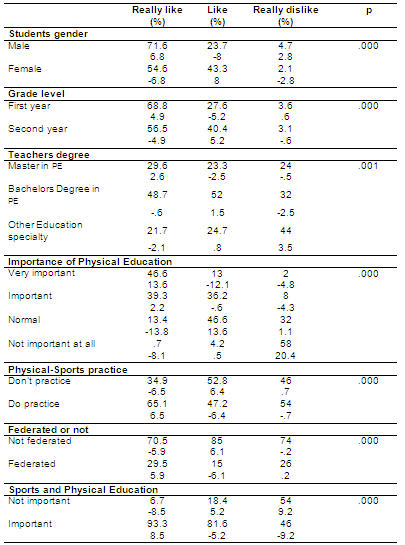
2.2 Results according to the content and objective assessment
The positive contents of the variable “Physical Condition and Health” were assessed favorably by 48.3% of the students who stated they “Really like” Physical Education; 83% of this group assessed the positive contents of “Games and Sports” favorably, as indicated in Table II. The content of the first variable was not assessed positively by 65.4% of the students who stated they “Like” PE; the content of “Games and Sports” was assessed the same way by 26.1% of the same students. However, 28.1% of this group assessed favorably the contents of “Corporal Expression”. In this same sense, 82% of the students who answered they “Really dislike” PE assessed negatively the positive contents of both “Physical Condition and Health” as well as “Corporal Expression”, although the percentage of students corresponding to this assessment was of 92% (p<.001).
With significant differences (p<.001), “Physical Condition and Health” as well as “Games and Sports” were not assessed negatively by 76.7% and 95.2% respectively of the students who said they “Really like” Physical Education; Instead, the first variable received a negative rating when the class answered “Like” (36.6%) or “Really dislike” (50%). The second variable “Games and Sports” was assessed the same way by 24% of the students if they said they “Really dislike” PE “Corporal Expression” was rated negatively when they answered they “Really like” PE (59.2%) and when they stated they “Really dislike”(72%);however, it wasn’t assessed negatively when PE was liked (50.8%). On the other hand, and with significant differences (p<.05), activities in “Natural settings” were assessed negatively by 36% of those who said they “Really dislike” PE.
According to the data presented in Table II, the objectives of Physical Education classes related to “Health”, “Competition” and “Education” were assessed positively by 85%, 29%, and 51.2% of the students who said they “Really like” Physical Education respectively. Additionally, they weren’t assessed positively by 21.1%, 81.6%, and 64% respectively of the students who said they “Like” the class, as well as 34% and 82% of those who stated they “Really dislike” PE (p<.001).
Table II. The percentage distribution, corrected typified residuals and significance of the interest in Physical Education according to the assessment of contents and objectives
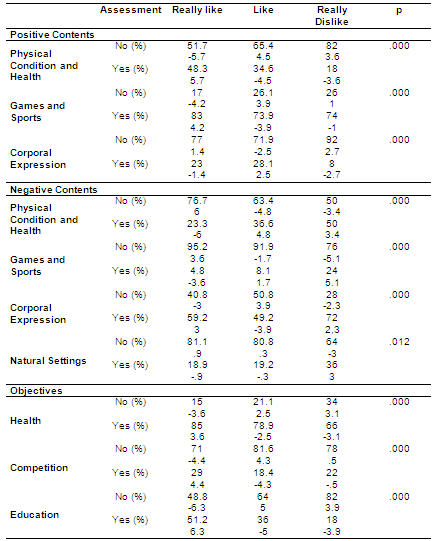
2.3 Results According to the Importance of Physical Education
In the case of those students who opted for “Alternative courses should not be offered” at Physical Education hours, 85.6% said they “Really like” PE; on the other hand, 31.2% and 78% of those who opted for “Alternative courses should be offered”, said they “Like” and “Really dislike” PE, respectively, as shown in Table III. The differences were significant (p<.001).
From the students who wouldn’t take Physical Education as an open elective, 39.5% and 68% of them stated they “Like” and “Really dislike” PE respectively; however, 76% of those who would take PE as an open elective said they “Really like” PE (p<.001).
The information shown on Table III indicates that 98.5% of those who preferred “not to have less hours” of PE manifested they “Really like” PE. On the contrary, 16.2% and 68% of those who wished they had less hours of Physical Education answered respectively that they “Like” and “Really dislike” PE (p<.001).
Table III. Percentage Distribution, corrected typified residuals and significance of the interest in Physical Education depending on its importance
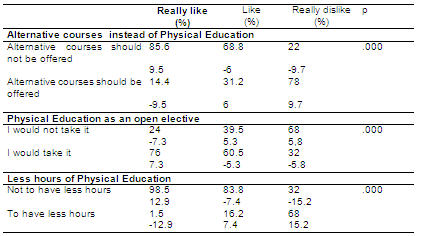
2.4 Results according to the assessment of Physical Education classes and their usefulness
With significant differences (p<.001), Physical Education classes were easy for 54.8% of the students who said they “Really like” the class, while they weren’t assessed positively by 64.4% and 82% of the students who said they “Like” and “Really dislike” PE respectively. In the same manner, classes were motivating for 42.9% of those who said they “Really like” the Physical Education class and they were not motivating for 77.1% of those students who said they “Like” PE classes and 94% of those who said they “Really dislike” them. Also, classes were considered “Useful” by 54% of the students who said they “Really like” PE classes, and it was considered less useful by 60.7% and 96% of the students who said they “Like” and “Really dislike”, respectively. 28.1% of the students who said they “Really like” PE said the teacher encouraged them to practice outside school hours and the teacher didn’t encourage to 81.6% and 92% of the students who “Like” and “Really dislike” Physical Education respectively. Finally, Physical Education classes were enough for 33.4% and 68% of those students who said they “Like” and “Really dislike” PE classes, respectively, while 90.8% of the students who said they “Really like” the class, said the classes were not enough.
With significant differences also (p<.01), it was observed that the students who said they “Really like” Physical Education also considered it the most important course (6.6%), while 97.8% of the students who said they “Like” PE did not consider it too important (see Table IV).
In the case of those students who said “Really like” PE, 46.6% assessed positively that it helped to relate to others and 8.6% assessed positively that it helped them to be smarter. On the contrary, the assessments made by 61.6% and 96.8% of the students who said they “Like” the subject, respectively, were negative on those variables. Finally, 76% of those who said they “Really dislike” considered that it will not help them relate to others and 98% said it wouldn’t help them to be smarter. The differences resulted significant (p<.01).
On the other hand, it was observed that 92.3%, 47% and 34.9% of the students who said they “Really like” PE assessed positively the fact that it helped them to improve their physical condition and health, to be better coordinated and to respect others, the equipment and the environment, respectively. The assessment was the opposite for the same variables made by those who said they “Like” the course; 12.6%, 58.9% and 72.9% respectively. In those students who said they “Really dislike” PE, the percentages were distributed: 16%, 72% and 80% respectively. The differences in this case are also significant (p<.01).
Table IV. Percentage Distribution, corrected typified residuals and significance of the interest in Physical Education depending on its assessment and usefulness
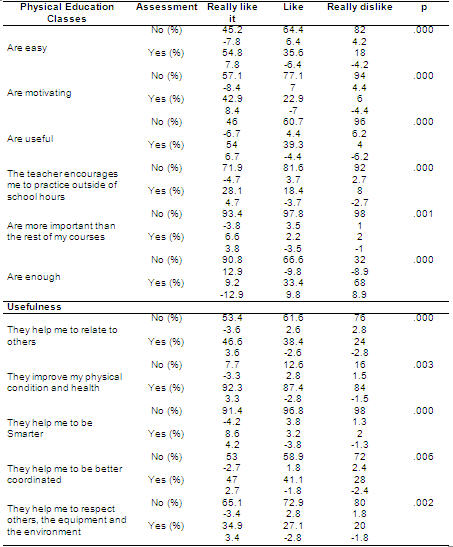
2.5 Results according to the attitude of the teacher and the student
As it can be observed in Table V, the students who said they “Really like” Physical Education assessed positively the “Good”, “Nice”, “Fair”, “Understanding” and “Happy” attitudes of the teacher on 62.1%, 51.7%, 35.1%, 20.7% and 40%, respectively. Those who stated they “Like” Physical Education assessed them the other way around in the following proportions: 59.3%, 64%, 73.5%, 86.2% and 73.1% of. For the group who said they “Really dislike” the class, the distribution of negative assessments for the attitudes was of 94% “Good” , 100% “Nice”, 82% “Fair”, 98% “Understanding” and 86% “Happy” (p<.001).
With significant differences (p<.001), 62.5% and 32.2% of the students who said they “Really like” Physical Education expected the teacher participated and corrected them in class, respectively; instead, these attitudes stopped being assessed positively by 46.6% and 80.2% of those who stated they “Like” the class. From the students who stated they “Really dislike” PE, 70% didn’t assessed positively the participation of the teacher in class and 68% assessed the attitude of “Correcting in class “in the same form.
On the other hand and with significant differences (p<.01), it was observed that 49.4% and 38.1% of the students who said they “Really like” PE wished the teacher would encourage the class and practiced sports, respectively. However, these attitudes were not assessed positively by students who said they “Like” PE; the proportions were: 58.1% for “Encouraging” and 68.8% for “Sports practice”. Finally, 68% of those who said they “Really dislike” the course assessed negatively both attitudes.
Table V. Percentage Distribution, corrected typified residuals and significance of the interest in Physical Education according to the attitude of the teacher and the student
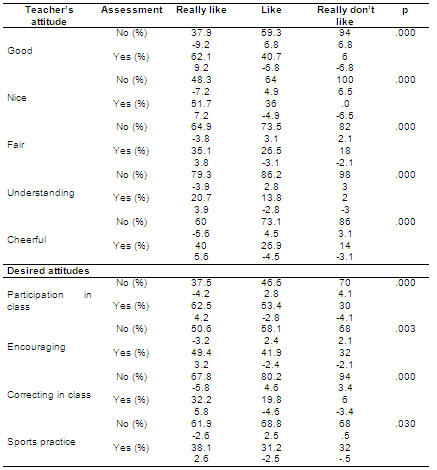
III. Discussion and conclusions
The results lead to think that Physical Education turns out to be more interesting and preferred by male than female students, which coincides with other research papers that affirm this same and they add that they find that the activities are more fun (Ruiz, 200; Torre, 1998).
When relating the course level that the students are taking with the interest in PE, it is found that the first year students show a higher interest in the class; as for second years, their liking is considered regular. The loss of the positive attitudes towards the course increases with their age; it is a verifiable fact in a multitude of research works. Pieron, Telama, Almond and Carreiro (1999) conducted a study in several European countries on attitudes towards Physical Education at school with students from both genders aged between 12 and 15, and they found that the most unfavorable attitudes were registered in 15 year female students. These results match those obtained by Moreno, Rodriguez and Gutierrez (2003) from a sample of students of both genders aged 12 to 15 which highlighted that the attitude and the interest towards the class declined as the students passed the course. Similar results were obtained by Casimiro (1999), Mendoza, Sagrera and Batista (1994) and Ruiz (2000), among others.
There is direct relation between the importance that the student attributes to PE and the interest shown for it. Students highly interested in the class; also consider it very important or important; as their interest decreases, so does the level of importance, until considered normal. In this sense, when it stops being interesting, it also stops being important. Torre (1998) had similar results when he found that the importance that the students attributed to classes depended largely to self-determination and self-esteem experienced in class.
The analysis of interest according to the contents evidences that “Physical Condition and Health” just like “Games and Sports” are the best assessed by students who really like PE, while “Corporal Expression” turns out to be the best assessed content by those who like PE The lack of interest for the subject causes the content to stop being assessed positively and the same happens with “Physical Condition and Health”, “Games and Sports”, “Corporal Expression” and activities in “Natural settings”; if interest increases, the contents negatively assessed are “Physical Condition and Health” and “Games and Sports”. Finally, when interest is at the highest level, only “Corporal Expression” is assessed negatively.
The results match those presented by Torre (1998) in his research on the interrelation between the extracurricular physical-sport activity and the Physical Education students of intermediate education. In it he revealed that the boys and girls, who really liked Physical Education classes, were those who gave greater importance to the contents of physical condition, collective sports, rhythm and relaxation.
Regarding the negative assessment of the contents of “Corporal Expression”, it can be concluded that it is affected not only by how frequently the teacher teaches dance and corporal expression, but by the method used in class also, which is very different to the one used in traditional sports practices.
In the same way, students’ interest in PE makes them eliminate the possibility of taking another class or doing anything else as an alternative, an option that they may consider when they stop liking the class. This result is similar to the one obtained by Moreno and Cervello (2004) on a paper with third graders in an elementary school, where they proved that those students who liked the course rejected the idea of studying or carrying out another activity at PE hours apart from those pertaining to the class.
The interest in the class makes the student prefers it as an open elective when against other courses, but, as the interest decreases, his preference for other courses increases. The interest in Physical Education contributes to the student’s favorable opinion when referring to the fact of receiving more PE class hours. Casimiro’s (1999) observed that students of elementary school were the ones who demanded more hours and showed greater interest for PE, which resembles the results in this paper.
As for the assessment of Physical Education classes according to the interest shown, it was verified that when there is a high interest in the class, students find the classes easier, motivating and of greater use since physical condition is enhanced; it helps them to relate to others, to be smarter and more coordinated. In this sense, it is considered that the teacher helps students get interested in extracurricular physical-sports and to assess positively the importance of the class in relation to the rest of the courses. Likewise, these students demand more weekly classes, while less interested students think that the number of weekly classes is enough. If the explanatory children motivation models toward physical activity are applied to the Physical Education class, it is possible to prove that when the physical skills of the student correspond to the demands of the teacher, the response results in the increase of physical self-esteem and consequently, in a positive attitude toward the class: Physical Education.
Consequently, the interest in the course makes the students assess positively the objectives related to “Health”, “Competition” and “Education”. Also, it influences the students when they assess the teacher’s attitude in class as: “Good”. “Nice”, “Fair”, “Understanding” and “Cheerful”. Hence, the attitudes expected from the teacher in class are: “Participation in class”, “Encouraging”, “Correcting in class” and “Sports practice”; this last one is shown by the teacher when dressed in sportswear. These results are related to those obtained by Moreno et al. (2002).
Another important result is also related to the level of interest shown by the students towards the course, the fact that it increases when the teacher has a “Masters in Physical Education”, and it decreases if the teacher’s degree is a Science Degree in Physical Activity and Sport or another education specialty. The Physical Education teacher , as someone who encourages and dynamizes in class, has been an object of attention of numerous research papers (Casimiro, 1999; Earl and Stennet, 1987; Figley, 1985; Hellin, 2001; Luke and Sinclair, 1991; Moreno et al., 2003; Moreno and Hellin, 2001; Torre, 1998; Velasquez and Hernandez, 2001). The conclusions are that academic training, participation in class, the interest shown by students, the design of attractive and motivating classes are factors that awaken positive students’ attitudes towards PE.
On the other hand, it can be observed that the student physical-sports practice relates to his interest for PE, and his liking for it is greater when he practices a sport and does it in a federated form (Hellin, 2003).
In general, the students who assess Physical Education positively recognize its importance, along with Sports’, in the country’s culture.
The fact that Physical Education is better liked by those students who do extracurricular practice and those who are federated should take to the reflection on how class is delivered to students. Which of the following objectives: performance, technique improvement, results or the assessment on personal effort and cooperation should be achieved? According to one or the other, interest in PE can be stimulated in a great number of individuals, and not only in a few of them, which will bring at the same time positive opinions on the importance of Sports and Physical Education for country’s culture.
References
Casimiro, A. J. (1999). Comparación, evolución y relación de hábitos saludables y nivel de condición física-salud en escolares, entre final de Educación Primaria (12 años) y final de Educación Secundaria Obligatoria (16 años). Unpublished PhD Thesis, Universidad de Granada, Spain.
Cervello, E. (2000, September ). Una explicación de la motivación deportiva y el abandono desde la perspectiva de la Teoría de Metas: Propuestas para favorecer la adherencia a la práctica deportiva. Paper presented in the First Hispano-Portuguese Congress of Psychology, Santiago de Compostela, Spain.
Earl, L. M. & Stennet, R. G. (1987). Student attitudes toward physical and health education in secondary schools in Ontario, Canadian Association for Health. Physical Education and Recreation Journal, 53 (4), 4-11.
Escarti, A. and Brustad, R. (2000, September). El estudio de la motivación deportiva desde la perspectiva de la teoría de metas. Paper presented in the First Hispano-Portuguese Congress of Psychology, Santiago de Compostela, Spain.
Fernandez Garcia, E. (1995). Actividad Física y Género: Representaciones diferenciadas en el futuro profesorado de Educación Primaria. Unpublished PhD Thesis, Universidad Nacional de Educación a Distancia, Madrid, Spain.
Figley, G. E. (1985). Determinants of attitudes toward Physical Education. Journal of Teaching in Physical Education, 4, 229-240.
Florence, J. (1991). Tareas significativas en Educación Física Escolar. Barcelona: Inde.
Fox, K. And Biddle, S. (1988). The child’s perspective in physical education. Part 2: Children’s participation motive. The British Journal of Physical Education, 19, 79-82.
Gutierrez, M. (2000, enero/marzo). Actividad física, estilos de vida y calidad de vida. Revista de Educación Física, 77, 5-14.
Hellin, P. (2001). La Educación Física y las actividades físico-deportivas recreativas para los técnicos en animación deportiva: valoración de su plan de formación. Diploma de Estudios Avanzados, Universidad de Murcia, Spain.
Hellin, P. (2003). Hábitos físico-deportivos en la Región de Murcia: implicaciones para la elaboración del currículum en el ciclo formativo de actividades físico-deportivas. Unpublished PhD Thesis, Universidad de Murcia, Spain
Hellin, P. & Moreno, J. A. (2001a). Actitudes hacia la Educación Física de los alumnos de ciclos formativos. Actas del II Congreso de Ciencias de la Actividad Física y el Deporte (pp. 549-557). Valencia: Universidad de Valencia.
Hellin, P. & Moreno, J. A. (2001b). Importancia de la Educación Física. Actas del 2º Congreso Internacional de Educación Física y Diversidad (pp. 693-708). Murcia: Consejería de Educación y Universidades.
Hellstedt, J. C. (1995). Invisible players: A family systems model. In S. M. Murphy (Ed.), Sport Psychology Inteventions (pp. 117-146). Champaign, IL: Human Kinetics.
Lopez, A. & Gonzalez, V. (2001). Niveles de satisfacción por la clase de Educación Física. Revista Digital Lecturas: Educación Física y Deportes, 32. Retrieved January 22, 2003, from: http://efdeportes.com/efd32/satisf.htm
Luke, M. & Sinclair, G. (1991). Gender difference in adolescents’ attitudes toward school physical education. Journal of Teaching in Physical Education, 11, 31-46.
Martin-Albo, J. (2000). La motivación en los deportes de equipo: análisis de las motivaciones de inicio, mantenimiento, cambio y abandono. Un programa piloto de intervención. Revista Digital Lecturas: Educación Física y Deportes, 24. Retrieved March 14, 2003, from: http://www.efdeportes.com/efd24/tdj.htm
Mendoza, R., Sagrera, M. R., & Batista, J. M. (1994). Conductas de los escolares españoles relacionadas con la salud. Madrid: CSIC.
Moreno, J. A. (1999). Motricidad Infantil. Aprendizaje y desarrollo a través del juego. Murcia: DM.
Moreno, J. A. & Cervello, E. (2003). Pensamiento del alumno hacia la Educación Física: su relación con la práctica deportiva y el carácter del educador. Revista Enseñanza. Anuario Interuniversitario, 21, 345-362.
Moreno, J. A. & Cervello, E. (2004). Influencia de la actitud del profesor en el pensamiento del alumno hacia la Educación Física. Revista Internacional de Ciencias Sociales y Humanidades, XIV (1), 33-51.
Moreno, J. A. & Hellin, P. (2001). Valoración de la Educación Física por el alumno según el género del profesor. Actas del XIX Congreso Nacional de Educación Física y Escuelas Universitarias de Magisterio (pp. 1267-1275). Murcia: Universidad de Murcia.
Moreno, J. A., Rodriguez, P. L., & Gutierrez, M. (2003). Intereses y actitudes hacia la Educación Física. Revista Española de Educación Física, 11 (2), 14-28.
Moreno, J. A., Sanchez, M., Rodriguez, D., Prieto, M. P., & Mula, C. (2002). ¿Puede el comportamiento del profesor influir en la valoración que el alumno realiza de la Educación Física? In A. Díaz, J. A. Moreno, & P. L. Rodríguez (Eds.), III Congreso de Educación Física e Interculturalidad. Murcia: Consejería de Educación.
Musitu, G., Roman, J. M., & Gutierrez, M. (1996). Educación familiar y socialización de los hijos. Barcelona: Idea Books.
Papaioannou, A. (1994). Development of a quiestionaire to measure achievement orientation in psyquical education. Research Quarterly for Exercise and Sport, 65, 11-20.
Papaioannou, A. (1995). Diferential perceptual and motivational patterns when different goals are adopted. Journal of Sport and Exercise Psychology, 17, 18-34.
Papaioannou, A. (1998). Goals perspectives reason for being disciplined and self-reported discipline in physical education lesson. Journal of teaching in Physical Education,17, 421-441.
Pieron, M., Telama, R., Almond, L., & Carreiro Da Costa, F. (1999). Estilo de vida de jóvenes europeos: un estudio comparativo. Revista de Educación Física, 76, 5-13.
Ruiz, F. (2000). Análisis diferencial de los comportamientos, motivaciones y demanda de actividades físico-deportivas del alumnado almeriense de enseñanza secundaria post-obligatoria y de la universidad de Almería. Unpublished PhD Thesis, Universidad de Granada, Spain.
Torre, E. (1998). La actividad físico-deportiva extraescolar y su interrelación con el área de Educación Física en el alumnado de Enseñanzas Medias. Unpublished PhD Thesis, Universidad de Granada, Spain.
Velázquez, R & Hernández, J. L. (2001). Deporte, práctica deportiva y formación de actitudes y valores: el caso de la Comunidad de Madrid. Actas II Congreso de Ciencias de la Actividad Física y el Deporte (pp. 935-946). Valencia: Universidad de Valencia.
Translators: Eleonora Lozano Bachioqui and Graciela Johnson.
1People who are affiliated to a sports club to compete
Please cite the source as:
Moreno, J. A. & Hellin, M. G. (2007). Compulsory secondary education students’ interests towards physical education. Revista Electrónica de Investigación Educativa, 9 (2). Retrieved month day, year, from: http://redie.uabc.mx/vol9no2/contents-moreno.html





